I have written previously that my love of railways, especially narrow gauge and industrial railways, was inspired by my late uncle Alan J Maund.
In addition to being a renowned railway photographer and artist, Alan was responsible for rescuing and restoring a steam locomotive that, were it not for his enthusiasm and determination, would be lost to us today.
Alan discovered Kerr Stuart Wren class locomotive number 3114 in a derelict state resting in a farmyard in Worcestershire in 1959. He purchased the locomotive and moved it to his parent’s home at Hindlip near Worcester. Over the next couple of years, with the help of friends and his father restored the engine. The engine would spend just over a decade at Hindlip running on a 100-yard section of track, which I believe he called the Hindlip and District Light Railway.
Alan’s restoration of 3114 is beautifully recorded in a handwritten booklet that he wrote in 1961; it is hard to believe that the meticulous text is handwritten; his account is illustrated with photographs and exquisite line drawings that he also drew. For anyone interested in the whole story of the restoration, the booklet has been made available to download at the request of my aunt by a book railway book publisher whose father was a great friend of Alans. The booklet can be downloaded here.
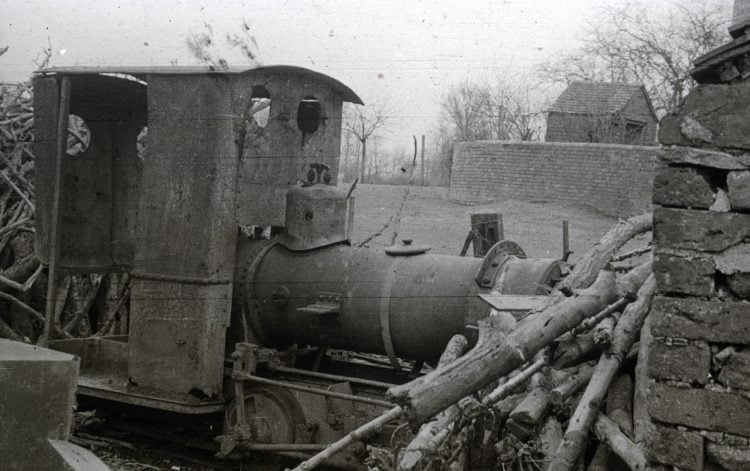
3114 was built in 1918; she began her working life with the Army working at an arms dump in Driffield in the East Riding of Yorkshire. She later went on to work on civil engineering projects, including building the Fernilee Reservoir in Goyt, Derbyshire.
3114 is believed to have spent time on the Ashover Light Railway. She eventually came to rest at Brockamin Farm near Malvern in Worcestershire, where Alan rescued her. In his booklet, Alan wrote, “The working life of 3114 had been a hard one. She was employed almost continuously for 30 years, and her well-worn tyres bear testimony to a considerable mileage”.
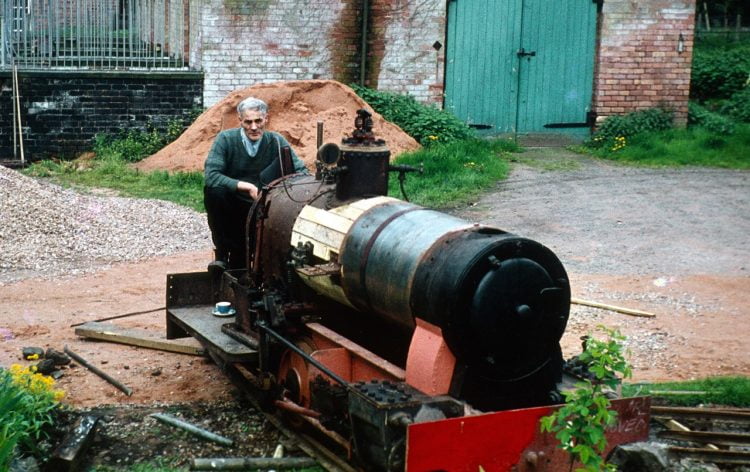
During the 13 years that 3114 resided in my grandparent’s garden, I was born. Some of my earliest memories are of playing on the locomotive and especially seeing it when in steam.
Although I would have been too young to have ever driven the loco, I vividly recall Uncle Alan explaining to me how the engine worked and what all the levers and equipment did. 3114 left Hindlip in 1971 or 1972, and from there went, I believe to a museum. I understand that some years later, it was again restored by another enthusiast in their garden. The engine later spent time at the Bala Lake Railway before going to its present home at the Vale of Rheidol Railway (VOR).
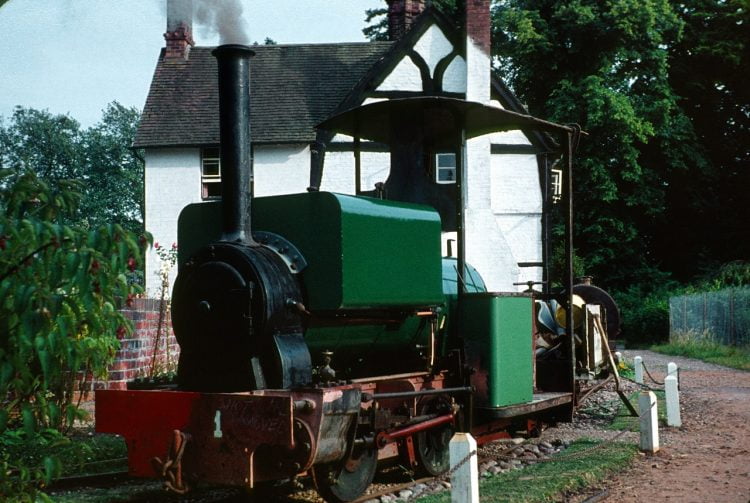
Since last seeing 3114, I grew up, started working, married, and had a family. My enthusiasm for railways never faded but was firmly on the back burner. I often thought about the loco during the years, and once with my wife even visited the museum; I thought it had gone to in the hope of seeing it.
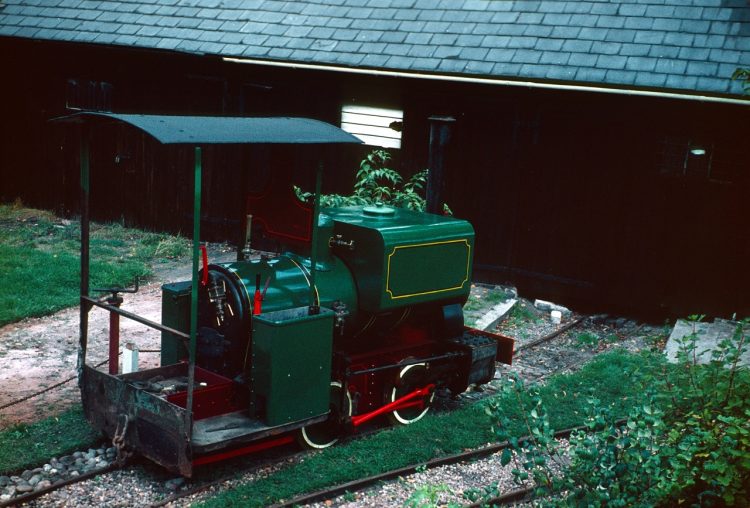
Since retiring, I have rekindled my love of railways and started visiting heritage lines, narrow gauge, and miniature railways. I have written about some of my trips for RailAdvent, including those to Statfold Barn, Rudyard Lake and some of the Great Little Trains of Wales.
I also started subscribing to the social media channels and newsletters of many lines around the country. Imagine my delight when on July 14th, the following post popped up on my social media feed from the VOR.
“Our “Wren” locomotive rolled out of the Aberystwyth workshop today after an overhaul and a repaint, and we think it looks fantastic.
It will soon be heading up to Devil’s Bridge, ready for service on Driver Experience throughout the summer. If you have ever dreamt of driving a steam locomotive, we can make those dreams come true!”
A phone call to the railway was made within a couple of days, and a plan to visit was hatched. The railway was extremely helpful when I phoned and explained why I wanted to see it. The gentleman I spoke to on the phone advised what days 3114 would be running on the Driver Experience’ at Devils Bridge and suggested that I visit before the school summer holiday starts as it can get very busy.
I was up early to walk to my home railway station Wellington where I caught the 07:07 service to Aberystwyth, the train for my journey was the class 158, diesel multiple unit 158838. I enjoyed the journey passing through the Welsh countryside, even though I live near a line with direct trains to Aberystwyth. This was the first time I had ever made the journey by train. I arrived at Aberystwyth station just a couple of hours after leaving Wellington and made the short walk from the end of the mainline platform via a walkway to the VOR station.
The Vale of Rheidol station at Aberystwyth is splendid with the recently completed rebuild and refurbishment of the previous station and facilities. The work has attempted to replicate, as far as possible, a Great Western Railway-style station, the attention to detail is fantastic, and the station is clean and welcoming. The toilets on the platform alone are worth visiting.
A new museum and display are due to open within the next year or so in the refurbished former engine shed; although not yet open, the building looks stunning.
I waited on the platform for the first train of the day, the 10:30 to Devils Bridge; I chatted with a driver Jac Smith, who would also be driving my train to Devil’s Bridge as he made his way to collect the rake of carriages that would form the train with one of the railways, small diesel locomotives, number 10 a 0-6-0 locomotive built in 1987 by the Brecon Mountain Railway.
The rake consisted of two open carriages, three enclosed standard-class carriages and a first-class observation saloon. The carriages had recently been refurbished and painted into a crimson and cream or ‘blood and custard’ livery; they looked great.
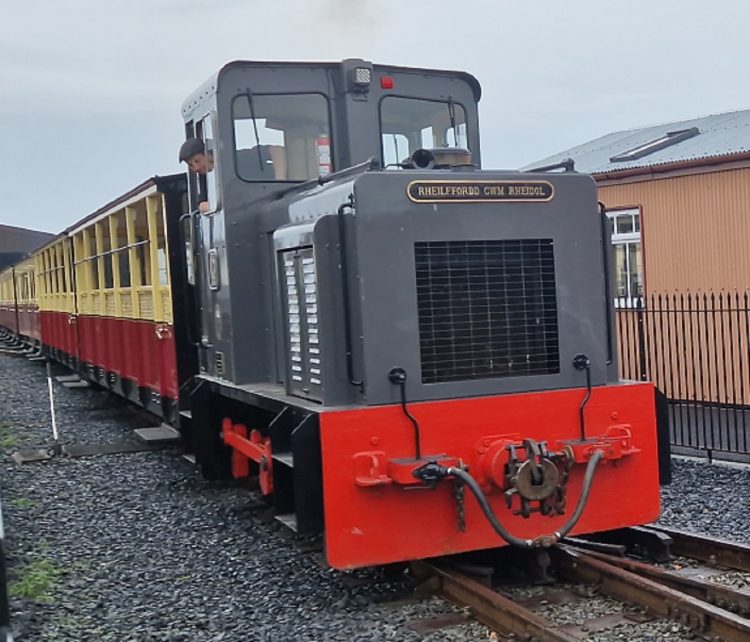
Number 10 was taken off the front of the rake to make way for the locomotive for our journey. Number 60 ‘Drakensberg’ is a 2-6-2 2-6-2 steam locomotive built by Hanomag in 1927. This impressive, red-liveried loco is a Garratt NG/G13 built for the South African Railways.
After withdrawing from service in South Africa in 1973, it ended up in Switzerland, where enthusiasts restored it. It ran on the Schinznacher Baumschulbahn line until changes to the track layout meant the loco could no longer operate on the line.
When Number 60 arrived at the Vale of Rheidol railway, it underwent regauging and modification work to enable it to run on the VOR. It pulled its first passenger train along the line in October 2021.
While waiting to board the train, I talked with Kian Holdsworth, the guard on the train I would be travelling on. He told me he is an engineering apprentice working at the railway. He was interested in the reason for my visit and connection with 3114.
Because it was raining, I boarded one of the enclosed standard-class carriages. Despite the low cloud and drizzle, I thoroughly enjoyed the 12-mile journey along the Rheidol Valley and the climb up to Devils Bridge. There are spectacular views of the valley and surrounding Welsh hills; the winding track also afforded numerous views of the loco at the front of the train as it worked hard, pulling the train up the line. Although I had spent many holidays in West Wales, this was the first time I had ridden on the VOR, and I wasn’t disappointed.
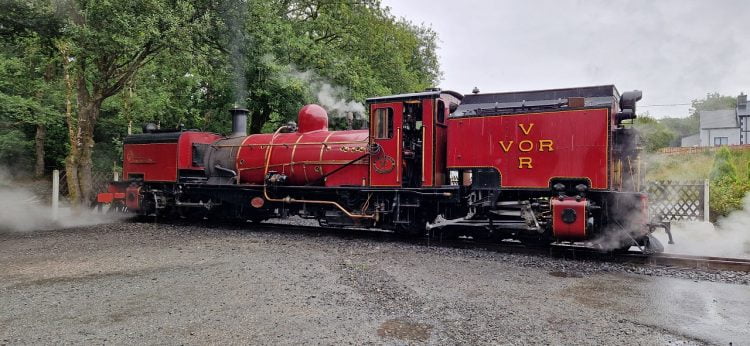
After leaving Aberystwyth, the railway cuts through the agricultural scenery of the lower, travelling through wide open fields of sheep; however, things change as the train goes into ancient woodland and rugged mountain scenery as the line twists and turns, clinging to the hillside some 700 feet to reach Devil’s Bridge – home of the famous Mynach Falls and Devil’s Punchbowl.
The line’s history goes back to 1897 with an act of parliament authorising the building of the line. Construction of the railway faced initial delays in securing local capital, but Sir James Szlumper’s tenacity prevailed, and in 1901 work commenced.
Utilising materials and a locomotive, later christened Rheidol, salvaged from the defunct Plynlimon & Hafan Tramway, the railway finally opened its doors to the eager public on 22nd December 1902.
With hopes of rejuvenating the local lead mines, the railway proved instrumental in reopening some mines and transporting the precious ore to Aberystwyth for further distribution by rail or sea. The thriving timber trade also found a lifeline, primarily catering to the demand for pit props in the South Wales coal mines.
At the height of its prosperity in 1912, ambitious plans to electrify the line using hydroelectric power from the River Rheidol were considered, but control of the railway shifted to Cambrian Railways that same year, leading to the shelving of these proposals.
The tumultuous Great War of 1914-18 caused further setbacks, as the Rheidol United Lead Mine closed, passenger services diminished, and other mine traffic continued to decline. Despite this, a growing tourist trade partially offset the losses.
In 1923, Cambrian Railways merged with the Great Western Railway, leading to the complete withdrawal of goods services and the closure of the harbour branch. Subsequent years saw the gradual phasing out of the winter passenger service, and with the outbreak of the Second World War in 1939, the line shut down entirely for the duration of the conflict.
Post-war, the ownership of the railway passed to British Railways in 1948. Despite persistent threats of closure, it persevered as the last steam railway under British Rail’s control until its privatisation in 1989. I recall seeing the locomotives and carriages carrying the corporate BR blue livery with the white double arrow logo back in the 1970s. I still have a copy of the ‘Ian Allan, Motive Power, Combined Volume’ from 1978, which records that I had seen all three of the lines GWR built tank engines by that year.
Presently, the Vale of Rheidol Railway is lovingly owned and operated by a charitable trust devoted to renovating and enhancing the locomotives, carriages, and tracks, uncovering picturesque vistas unseen for decades. Apart from the Garratt locomotive that pulled my train up to Devils Bridge, the remainder of the steam fleet that operates along the whole line hauling passenger services consists of three 2-6-2 tank engines designed by Davies and Metcalfe for the Great Western Railway and built at the famous Swindon works in 1923.
As my train pulled into Devils Bridge, I caught my first sight in over 50 years of 3114 as it sat outside its little engine shed waiting for its first ‘driver experience’ customers. I felt quite emotional at seeing it.
As I left the platform, I was approached by railway staff who had been told why I was visiting. I guess that the driver or the guard I had spoken to earlier told them. Soon there were a few other railway staff keen to look at the copy of my uncle’s book I took. They were also interested in my story and connection to 3114.
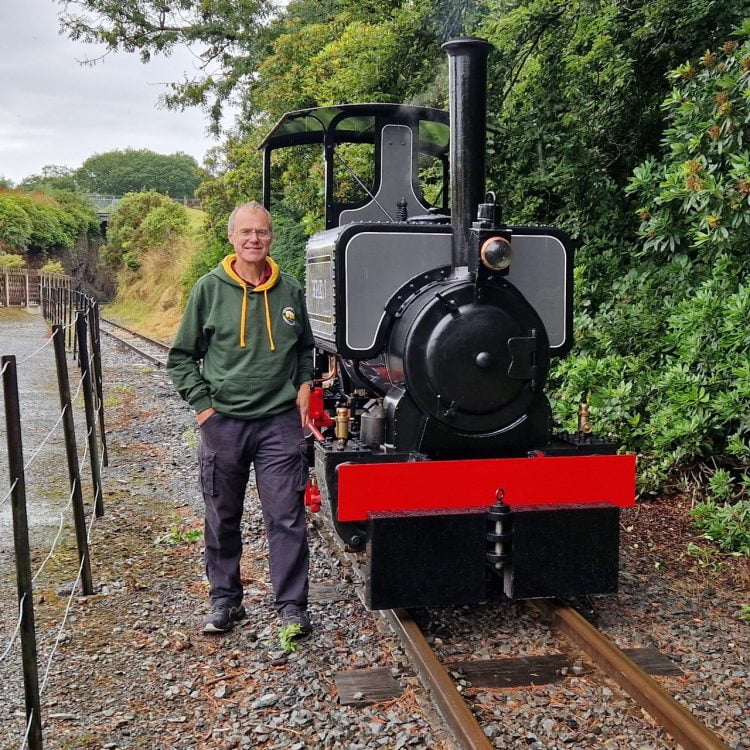
As previously mentioned, 3114 is a member of the Kerr Stuart Wren class. The 0-4-0 “Wren” Locomotives were a series of narrow-gauge steam locomotives built by Kerr, Stuart & Co. and later the Hunslet Engine Company, designed to serve narrow-gauge railways globally.
In 1905, Kerr, Stuart & Co. proudly presented the first Wren locomotive, and their production continued until 1941, culminating in the construction of 167 exemplary locomotives. Among these, an impressive 162 were masterfully produced by Kerr Stuart & Co., while the remaining five were expertly manufactured by Hunslet.
Earning the distinction of being the smallest class of locomotive featured in the Kerr Stuart & Co. catalogue, these sturdy machines predominantly found their calling in industrial settings, executing vital tasks like construction and quarry work.
Consequently, numerous Wren locomotives were shipped to various narrow-gauge railways across the United Kingdom, while others were exported for service on railways abroad. Their simple design made them easy to maintain and operate; they proved a reliable class of locomotive.
After years of faithful service on their respective railways, all 167 Wren locomotives were eventually retired from active duty, though their fates post-withdrawal remain largely unknown. For some, their journey concluded tragically as they were dismantled and scrapped. However, there is a silver lining: a fortunate few were rescued from oblivion, restored, and preserved for posterity, with some even undergoing meticulous restoration to regain their operational status.
I got to spend some time up close with 3114. I met Barney Rampton, who has worked as a fireman at the railway for seven years and was the Wren driver on the day of my visit. Barney was interested in my stories and connection to the engine; he told me it made a change from the usual ‘my grandad drove the Flying Scotsman’ story that he is often told and which has become a running joke amongst the railway staff.
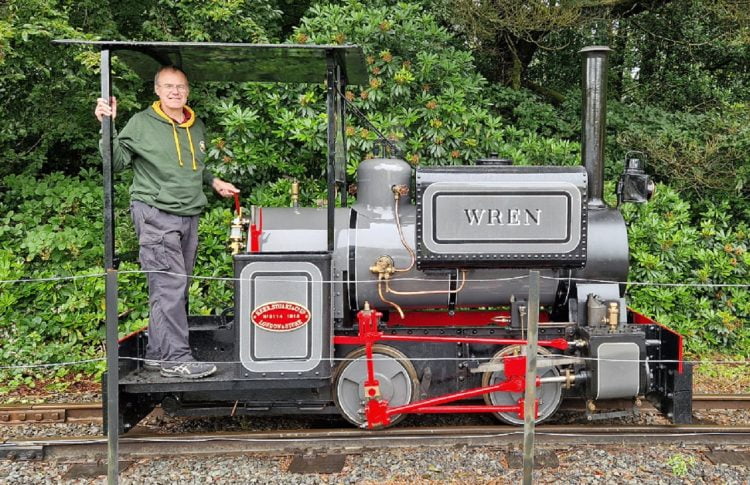
Barney showed me the locomotive, which I studied very closely. I was especially interested in the cast number plates that adored the side of each cab.
In his booklet, my uncle recalled how these were missing from the engine when it was found in 1959. Alan wanted to have as authentic as possible replacements plates made for 3114. He wrote, “so that we might achieve authenticity, an original plate was required for a pattern and, if possible, to be of 1918 vintage. The very thing was found in North Wales on the Penrhyn Slate Quarries engine ‘Sgt Murphy’ KS 3117. The plate was kindly lent to us, and by simply changing the seven to a four, the new plates were quickly produced”. I was keen to know if the plates Alan had made were still the ones that adorn the loco today. Touching the plates, it is possible to feel some imperfections around the number 4 not present elsewhere on the plate; this will have been as the 7 would have been changed to a 4 in the mould. Therefore, I am as certain as possible that these are the same replica plates.
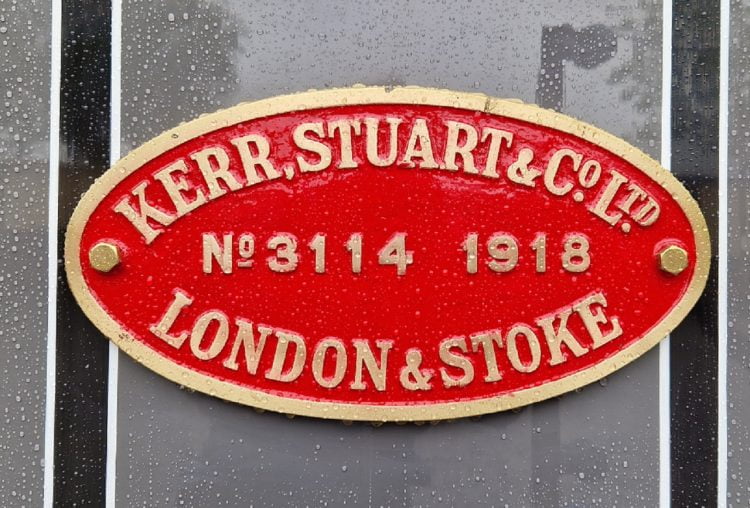
Barney told me that the one thing he doesn’t like about 3114 is its shrill whistle; whilst on the footplate, I gave it a short blast, and I must agree with him. Comparing photographs of the engine today with my uncle’s photos, I am pretty sure the whistle on 3114 today is not the same as the one back then.
I then got to realise a long-held dream to drive 3114. The engine is straightforward to drive, and I took it up and down the short length of track on which it runs several times. As it was quiet, Barney kindly afforded me as much as I wanted with the engine. It was a wonderful experience as I drove up and down. I couldn’t help but think of my uncle and grandfather doing the same all those years ago. Although I do not know for sure, I suspect that my mother and father probably took their turns at the regulator.
Sadly, I eventually had to leave Devils Bridge and catch my train back to Aberystwyth. Before I did, however, Barney arranged two more treats for me. Firstly, he took me onto the footplate of Vale of Rheidol loco number 8, which was amazing as I had seen this locomotive and its two sisters many times when holidaying in the area as a child. Finally, he spoke to the guard on the train I would be travelling on, who kindly found a seat in the first-class observation carriage behind the engine.
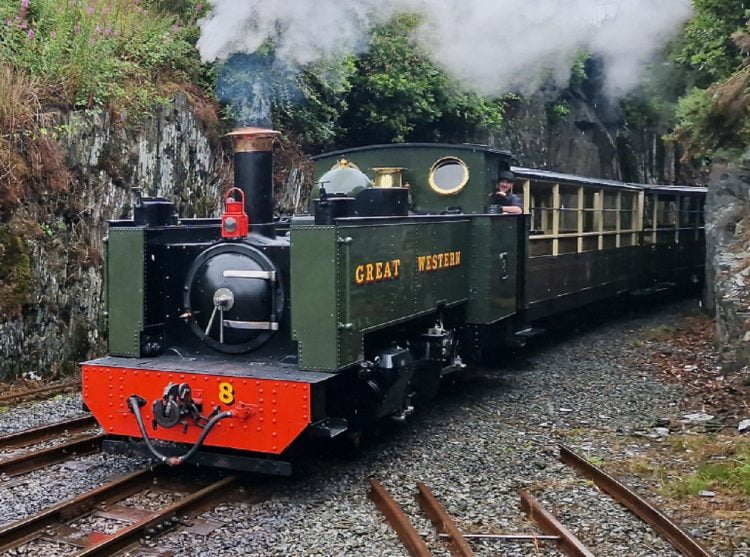
I arrived in Aberystwyth ten minutes before my mainline train back to Wellington; during my journey home, I had plenty of time to reflect on what a perfect day it had been.
I want to thank all the staff I encountered at the Vale of Rheidol Railway, their interest and kindness made what would have been a great anyway into one of the most memorable of my life.
Thank you also to my cousin, Alan’s daughter Sally, who kindly sent me his photographs of 3114, which I have included in this article.
Finally, thank you to my late uncle. Without Alan J Maund, 3114 would not still be with us and in operational order today. I know others have restored and been worthy custodians of the engine since. But without Alan, the loco would likely have ended up being scrapped.
I will finish with a final quote from Alan’s booklet about 3114
“After a century of service to industry, the narrow-gauge steam locomotive is now on the verge of extinction and for the few that are left the sands of time run fast. Fortunately, however in recent years, due in some degree to increasing standardisation on the mainline, interest in these engines has grown, and with it a realisation that here was something in danger of being lost for ever. Happily, this realisation became manifest in a surge of enthusiasm, and in direct consequence, the safekeeping of a number of these engines has been assured by the efforts of various museums, societies and private individuals, who like myself seek not only to indulge their own enthusiasm but to ensure the continued survival of these locomotives as a lasting monument to the past” A.J Maund 1961
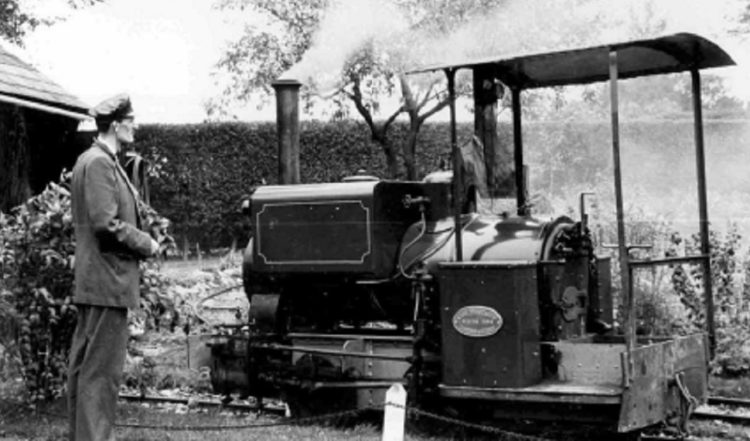






Responses
Amazing, great to find you still around, very sorry to have lost touch with so many people
Amazing, was very sorry I lost contact with so many people from that era
It was a pleasure to read this most interesting article, along with the downloaded booklet. Thank you very much Jon.
3114 left Hindlip on the 19th March 1971. The ‘working party’ consisting of the late Rich Morris, the late Andrew Wilson, Pete Nicholson and myself, employing a low loader belonging to Adams Bristow driven by Don Sturdee. 3114 went to Rich’s house at Longfield in Kent, remaining there until Ricch moved to North Wales, firstly with a museum planned to be opened at Pen-yr-Orsedd but then relocating to Gloddfa Ganol.
Are you the same Pete Briddon I knew as a teenager in the 70’s running the narrow gauge line at West Park in Long Eaton?
Yep, ’tis me.